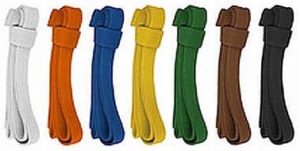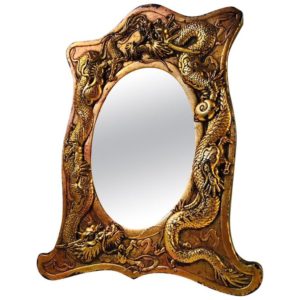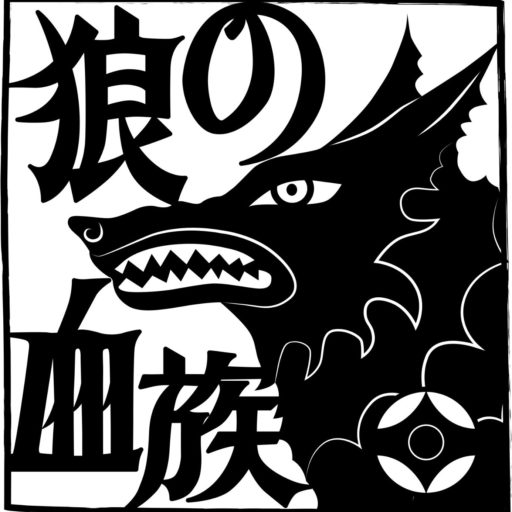by sherlock | Oct 3, 2021 | Kizuna
 Kyū (級) is the term used to designate various grades, levels or degrees of proficiency or experience. Kyū-level practitioners are called mudansha (無段者), “ones without dan”, when practitioners have reached the ranking of first degree black belt, they become shodan (初). The holder of a black belt of any degree is a yūdansha (有段者), “one with dan”.
Kyū (級) is the term used to designate various grades, levels or degrees of proficiency or experience. Kyū-level practitioners are called mudansha (無段者), “ones without dan”, when practitioners have reached the ranking of first degree black belt, they become shodan (初). The holder of a black belt of any degree is a yūdansha (有段者), “one with dan”.
Colored belts have their origin in judo, as does the training ‘gi’, or more correctly, ‘dōgi‘ or ‘Keikogi’. Originally the belts where white or black; white for the less experienced mudansha and black for the more experienced yudansha. White denoted simplicity and purity, and the white belt of the beginner showed that the student began empty, but eventually was filled with knowledge. Using colored belts to denote rank or ability in martial arts was introduced around the turn of the 20th century. Each colored belt has two levels, the second being represented by a stripe at the end of the belt.
Gradings provide an opportunity to test your skills and grow through the demands of a steadily increasing training workload but they are never to be taken for granted. They demand training experience and understanding of the requirements in more challenging degrees as you go through the different levels.
In Kyokushin the grading system is a skills-based system designed to encourage steady improvement; it is not a time-based system designed to recognise attendance frequency. Each student differs and thus progress comes at different rates, therefore, it is difficult to set time-frames which will suit everyone. Never take it for granted that because you have been training for a longer time than someone else or because you attend classes more often, you are automatically able to participate in a grading. Training is the accumulation of experience, and belts are simply a consequence of a constant and consistent pursuit of knowledge and skill.
Focus on your own training and don’t be concerned with making comparisons to others. Focus on steady and solid progress in skill and fitness through the gradual and sound gathering of experience. Ultimately gradings are a demonstration of your understanding of the required skills and overall spirit of Kyokushin.
Here a few suggestions to assist you in your training:
- Be honest with yourself in training. Neither overestimate or underestimate the skills and strength your training efforts have brought you. If we are too self-critical this can hinder our progress.
- Be confident, polite and civilized as you become part of the larger dojo family.
- Listen to sensei and senior students as they have the experience. If you are unsure of anything or have doubts, don’t hesitate to discuss it with sensei or senior students as they are in the dojo to help. Remember any senior student was in the same position you are in now.
- Karate is an individual sport practised as a team; so treat your training partners with respect as they are important to your development and you are as equally important to them.
- The more regularly you train, the deeper your understanding and faster your progress. Be disciplined and consistent; at the end of the day, only you can do this.
Everything adds to your total karate picture at any given level and a grading, when you are prepared, allows you to stand confidently amongst your peers. With an announcement of a a grading speak to sensei about participating and they will inform you whether they think you are ready. They base this judgement on numerous considerations:
- technical skill
- conditioning
- relative maturity
- attitude
- depth of experience
by sherlock | Jan 2, 2021 | Kizuna
 Kagami biraki (鏡開き) is a Japanese traditional ceremony which literally translates to “Opening the Mirror”. The meaning of the term kagami biraki refers to the transition from one stage to another. The New Year kagami biraki represents beginning the New Year with optimism. The kagami biraki tradition was adopted into modern martial arts starting in 1884 when Jigora Kano (the founder of judo) instituted the custom at the Kodokan, his organisation’s headquarters. Since then other Japanese arts, such as aikido, karate, and jujutsu, have adopted the celebration that officially kicks off the New Year; a tradition of renewal, rededication and spirit.
Kagami biraki (鏡開き) is a Japanese traditional ceremony which literally translates to “Opening the Mirror”. The meaning of the term kagami biraki refers to the transition from one stage to another. The New Year kagami biraki represents beginning the New Year with optimism. The kagami biraki tradition was adopted into modern martial arts starting in 1884 when Jigora Kano (the founder of judo) instituted the custom at the Kodokan, his organisation’s headquarters. Since then other Japanese arts, such as aikido, karate, and jujutsu, have adopted the celebration that officially kicks off the New Year; a tradition of renewal, rededication and spirit.
The origin of the ceremony is dated back to Tokugawa Ietsuna, the 4th Shogun of the Tokugawa clan (ruled 1651-1680). Ietsuna gathered his Daimyo at the castle of Chiyoda in preparation for a battle and. according to one version, displayed a mirror, performed a war dance in front of it and then prayed for victory. As Ietsuna won the battle, this became the beginning of the “Kagami Biraki” ceremony. To members of Japanese feudal society mirrors represented the soul or conscience, therefore, it was considered important to keep mirrors clean since it was thought that mirrors reflected back on the viewer their own thoughts.
A zen explanation of kagami biraki is the mirror contains an old image, for what one sees in the mirror is seen with old eyes. You see what you expect to see, something that conforms with your own self-image based on what you remember of yourself. In this way the eyes connect people with their past through the way they see their own image. This creates a false continual. Instead every moment holds potential for newness, another possibility for breaking with the old pattern, the pattern being just a mental restraint, something that binds us to the false self which people call “me.” By breaking or “opening” the mirror one breaks the self-image that binds people to the past, so as to experience the now, the present.
Kagami biraki in the dojo is the first official training of the year which is this Monday 4 January 2021 and is a time when we engage in a common endeavour and re-dedicate our spirit, effort and discipline towards our training goals. It is time for self-polishing and reflection by working on perfecting the self and reduce the ego; the concept hearkens back to the ancient concept of mirror polishing to keep the mind and resolve clear.
by sherlock | Jan 8, 2020 | Kizuna
Age is more an attitude than a tally as someone can be “old” at 30 and “young” at 70. How often have we looked back and thought “If only I <fill in the blank>, years ago, how much more I would have gained and/or achieved”. Fact is, we didn’t and it doesn’t matter as regretting it is not going to give back the time.
There is also the “I remember when <fill in the blank>” regret. Don’t define yourself by what you can’t do; focus on things you can do and do them well, and don’t regret the things you can’t. I remember when I use to do jodan mawashi geri without much effort, so they are a bit lower now and I’m a bit slower; does it really matter to the spirit of my training? If my answer was “yes”, then I should be examining why I am training. You may never be able to do some aspects of training as easily as others, or like “you use to”, does it really matter to the spirit in which you train?
Of course this can become a double-edged sword if you let it, inasmuch, there is a fine line between not physically being able to do something and giving up because it’s too hard. Only you can decide which it is.
Regret is a waste of energy as you cannot build upon it. Build on the dreams and make them realistic and achievable.
 Kyū (級) is the term used to designate various grades, levels or degrees of proficiency or experience. Kyū-level practitioners are called mudansha (無段者), “ones without dan”, when practitioners have reached the ranking of first degree black belt, they become shodan (初). The holder of a black belt of any degree is a yūdansha (有段者), “one with dan”.
Kyū (級) is the term used to designate various grades, levels or degrees of proficiency or experience. Kyū-level practitioners are called mudansha (無段者), “ones without dan”, when practitioners have reached the ranking of first degree black belt, they become shodan (初). The holder of a black belt of any degree is a yūdansha (有段者), “one with dan”.
 Kagami biraki (鏡開き) is a Japanese traditional ceremony which literally translates to “Opening the Mirror”. The meaning of the term kagami biraki refers to the transition from one stage to another. The New Year kagami biraki represents beginning the New Year with optimism. The kagami biraki tradition was adopted into modern martial arts starting in 1884 when Jigora Kano (the founder of judo) instituted the custom at the Kodokan, his organisation’s headquarters. Since then other Japanese arts, such as aikido, karate, and jujutsu, have adopted the celebration that officially kicks off the New Year; a tradition of renewal, rededication and spirit.
Kagami biraki (鏡開き) is a Japanese traditional ceremony which literally translates to “Opening the Mirror”. The meaning of the term kagami biraki refers to the transition from one stage to another. The New Year kagami biraki represents beginning the New Year with optimism. The kagami biraki tradition was adopted into modern martial arts starting in 1884 when Jigora Kano (the founder of judo) instituted the custom at the Kodokan, his organisation’s headquarters. Since then other Japanese arts, such as aikido, karate, and jujutsu, have adopted the celebration that officially kicks off the New Year; a tradition of renewal, rededication and spirit.